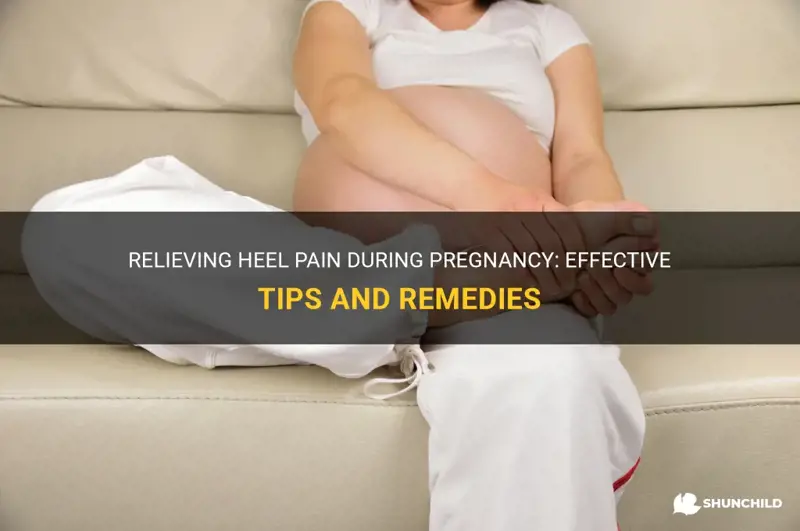
During pregnancy, it's not uncommon for women to experience various aches and pains, including the often dreaded heel pain. As the body undergoes significant changes to accommodate a growing baby, added pressure is placed on the feet, resulting in discomfort and soreness. However, there are several effective ways to relieve heel pain and make pregnancy a more comfortable experience. By implementing simple strategies such as stretching exercises, proper footwear, and even massage therapy, expectant mothers can find relief and continue to enjoy the journey of pregnancy.
| Characteristics | Values |
|---|---|
| Proper footwear | - Wear shoes with cushioning and arch support |
| Arch support inserts | - Use specialized shoe inserts with proper arch support |
| Stretching exercises | - Perform calf stretches and toe stretches regularly |
| Ice therapy | - Apply ice to the affected area for 15-20 minutes, 3-4 times a day |
| Elevation | - Elevate the feet whenever possible to reduce swelling and pressure on the heels |
| Massage | - Gently massage the heels and surrounding areas to alleviate pain and improve circulation |
| Supportive footwear at home | - Use supportive slippers or sandals at home instead of going barefoot, to provide cushioning and support |
| Rest and avoid prolonged standing | - Take regular breaks and avoid prolonged standing to reduce pressure on the heels |
| Pregnancy-appropriate exercises | - Engage in low-impact exercises like swimming or prenatal yoga to improve circulation and reduce swelling |
| Weight management | - Maintain a healthy weight to reduce stress on the feet and heels during pregnancy |
| Compression socks or stockings | - Use compression socks or stockings to improve circulation and reduce swelling in the feet and ankles |
| Over-the-counter pain relievers | - If approved by a healthcare provider, over-the-counter pain relievers like acetaminophen can be taken to manage heel pain during pregnancy |
| Supportive splints or braces | - Use supportive splints or braces specifically designed for relieving heel pain during pregnancy |
| Orthotic devices | - Consult a healthcare professional to get custom orthotic devices made to provide additional support and alignment for the feet and heels during pregnancy |
| Avoid high heels and unsupportive shoes | - Avoid wearing high heels or shoes with little to no support, as they can worsen heel pain during pregnancy |
What You'll Learn
- What are some effective exercises or stretches for relieving heel pain during pregnancy?
- Are there any specific types of shoes or inserts that can help alleviate heel pain?
- Is there a certain amount of rest or time off from physical activity that is recommended for reducing heel pain?
- Are there any over-the-counter pain relievers or topical creams that can provide relief for heel pain during pregnancy?
- Are there any alternative therapies, such as acupuncture or massage, that have been proven to be effective for relieving heel pain during pregnancy?

What are some effective exercises or stretches for relieving heel pain during pregnancy?
Heel pain is a common complaint during pregnancy, and it can be quite uncomfortable and debilitating. The weight gain and changes in posture that occur during pregnancy can put increased pressure on the feet, leading to heel pain. Thankfully, there are several exercises and stretches that can help to relieve heel pain and improve overall foot comfort during pregnancy.
One effective exercise for relieving heel pain is toe curls. This exercise involves sitting in a comfortable position with your feet flat on the floor. Slowly curl your toes, as if you were trying to pick up a small object with them. Hold the curl for a few seconds, then release. Repeat this exercise several times a day to help strengthen the muscles in your feet and alleviate heel pain.
Another helpful exercise is calf stretches. Stand near a wall or other sturdy object for support, and place one foot behind you, keeping it flat on the ground. Keep your heel down and slowly lean forward, feeling a stretch in your calf muscle. Hold the stretch for 30 seconds, then switch to the other foot. Repeat this stretch several times a day to help reduce heel pain.
Additionally, using a tennis ball or a frozen water bottle can provide relief for heel pain. Simply place the ball or frozen water bottle on the floor and roll it back and forth under the arch of your foot for a few minutes. The pressure from the ball or bottle can help to stretch and massage the muscles in your feet, reducing heel pain.
It's also important to wear supportive footwear during pregnancy to help alleviate heel pain. Look for shoes with good arch support and cushioning to help absorb shock and reduce pressure on the feet. Avoid high heels and flat shoes, as they can put additional strain on the feet and exacerbate heel pain.
In addition to exercises and stretches, there are other measures you can take to relieve heel pain during pregnancy. Applying ice to the affected area, elevating your feet when possible, and taking over-the-counter pain relievers (with your healthcare provider's approval) can all help to reduce inflammation and alleviate pain. It's important to note that if your heel pain is severe or persistent, it's always a good idea to consult with your healthcare provider for further evaluation and treatment options.
In conclusion, heel pain during pregnancy can be relieved through a combination of exercises, stretches, and lifestyle modifications. Toe curls, calf stretches, and rolling a tennis ball or frozen water bottle under your foot can all help to strengthen muscles, improve flexibility, and relieve heel pain. Wearing supportive footwear, applying ice, elevating your feet, and taking pain relievers (with your healthcare provider's approval) are additional measures that can be taken to alleviate heel pain. By incorporating these strategies into your daily routine, you can find relief from heel pain and enjoy a more comfortable pregnancy.
Understanding Excessive Swelling During Pregnancy: Causes, Prevention, and Remedies
You may want to see also

Are there any specific types of shoes or inserts that can help alleviate heel pain?
Heel pain can be a debilitating condition that affects the daily lives of many individuals. Whether it is caused by plantar fasciitis, Achilles tendonitis, or other conditions, finding relief from heel pain is a top priority for those who suffer from it.
While there are many treatment options available, one approach that has shown promising results is the use of specific types of shoes or inserts. These can help to alleviate pressure on the heel and provide support and cushioning to the affected area.
One type of shoe that is commonly recommended for individuals with heel pain is a walking shoe with a firm heel counter. The heel counter is the part of the shoe that wraps around the heel and provides stability and support. A firm heel counter can help to alleviate stress on the heel by preventing excessive movement and providing a stable base for the foot.
Another type of shoe that can be beneficial for heel pain is a shoe with a cushioned sole. These shoes provide added shock absorption and can help to reduce the impact on the heel with each step. Many athletic shoe brands offer models specifically designed for individuals with heel pain, featuring extra cushioning and support in the heel area.
In addition to specific shoe types, many individuals find relief from heel pain by wearing inserts or orthotics. These can provide additional support and cushioning to the foot, helping to distribute weight more evenly and reduce pressure on the heel. There are many different types of inserts available, including over-the-counter options and custom orthotics prescribed by a podiatrist.
When choosing inserts for heel pain, it is important to consider both the shape and material used. Inserts should be contoured to the shape of the individual's foot to provide the right amount of support and cushioning. Additionally, the material used should be able to absorb shock and provide proper arch support.
To further alleviate heel pain, it is also important to consider lifestyle factors. For example, individuals who spend a lot of time on their feet may benefit from wearing supportive shoes or inserts throughout the day. Additionally, stretching exercises and physical therapy can help to strengthen the muscles and tendons in the foot and ankle, providing long-term relief from heel pain.
In conclusion, there are many specific types of shoes and inserts that can help to alleviate heel pain. Walking shoes with a firm heel counter and cushioned sole can provide stability and shock absorption, while inserts and orthotics can provide additional support and distribute weight more evenly. By considering these factors and incorporating lifestyle changes, individuals can find relief from heel pain and improve their overall quality of life.
The Impact of Excessive Spinach Consumption During Pregnancy
You may want to see also

Is there a certain amount of rest or time off from physical activity that is recommended for reducing heel pain?
Heel pain is a common condition that can be caused by a variety of factors, such as plantar fasciitis, Achilles tendonitis, heel spurs, or stress fractures. One question that often arises is whether taking time off from physical activity can help reduce heel pain. In this article, we will explore the recommended amount of rest or time off from physical activity to alleviate heel pain.
When it comes to reducing heel pain, rest is an essential component of the healing process. Rest allows the injured tissues to recover and heal properly. It also helps to reduce inflammation and prevent further damage. However, the amount of rest required can vary depending on the severity of the injury and the individual's overall health and fitness level.
In general, it is recommended to take a break from high-impact activities that put stress on the heels, such as running, jumping, or playing sports. Instead, low-impact activities like swimming, cycling, or using an elliptical machine can be done to maintain fitness without worsening the condition. These activities provide a cardiovascular workout while minimizing the impact on the heels.
The duration of rest needed may vary from a few days to several weeks, depending on the severity of the heel pain. Mild cases of heel pain may require only a few days of rest, while more severe cases may necessitate several weeks of rest. It is important to listen to your body and give it the time it needs to heal properly.
During the rest period, it is also beneficial to incorporate stretching and strengthening exercises specific to the feet and calves. These exercises can help improve flexibility, reduce tightness in the muscles and tendons, and promote healing. Physical therapy or working with a qualified professional can provide specific exercises and guidance tailored to individual needs.
It is worth noting that while rest is important for healing heel pain, it is also crucial to address the underlying cause of the pain. Simply taking time off from physical activity may provide temporary relief, but if the root cause is not addressed, the pain may return once activity is resumed.
In addition to rest, other treatments may be necessary to alleviate heel pain. These can include ice therapy, nonsteroidal anti-inflammatory drugs (NSAIDs), custom orthotics, shoe modifications, and in severe cases, corticosteroid injections or surgery. It is recommended to consult a healthcare professional or a specialist in foot and ankle disorders for an accurate diagnosis and appropriate treatment plan.
To recap, taking a break from high-impact activities and incorporating low-impact exercises can help reduce heel pain. The duration of rest needed will vary depending on the severity of the condition. Stretching and strengthening exercises, along with other treatments, may also be beneficial. It is important to seek professional advice to address the underlying cause of heel pain and develop a comprehensive treatment plan. With the right approach and adequate rest, most individuals can experience a reduction in heel pain and return to their regular activities.
The Consequences of Extended Waiting: What Happens When You Leave a Pregnancy Test for Too Long
You may want to see also

Are there any over-the-counter pain relievers or topical creams that can provide relief for heel pain during pregnancy?
During pregnancy, many women experience discomfort and pain in various parts of their body. One common area that can be affected is the heels. Heel pain during pregnancy can be caused by a variety of factors, such as weight gain, changes in posture, and hormonal changes. Fortunately, there are a few over-the-counter pain relievers and topical creams that can provide relief for heel pain during pregnancy.
When it comes to over-the-counter pain relievers, it is important to choose ones that are safe for use during pregnancy. Non-steroidal anti-inflammatory drugs (NSAIDs) such as ibuprofen and aspirin are typically not recommended during pregnancy. However, acetaminophen is considered safe to use and can provide temporary relief from heel pain. It is important to follow the recommended dosage and consult with a healthcare provider before taking any medication during pregnancy.
In addition to over-the-counter pain relievers, there are also topical creams that can help alleviate heel pain during pregnancy. These creams often contain ingredients such as menthol or camphor, which provide a cooling sensation and help reduce inflammation. Applying these creams directly to the affected area can provide temporary relief and soothe discomfort. However, it is important to check the ingredients list and consult with a healthcare provider before using any topical cream during pregnancy.
While over-the-counter pain relievers and topical creams can provide temporary relief for heel pain during pregnancy, it is important to address the underlying causes of the pain to find long-term relief. Here are a few steps you can take to help alleviate heel pain during pregnancy:
- Wear supportive footwear: Opt for shoes with good arch support and cushioning to reduce pressure on the heels. Avoid high heels or shoes with narrow toe boxes, as they can exacerbate heel pain.
- Stretch and exercise: Gentle stretching exercises can help improve flexibility and reduce heel pain. Performing foot and calf stretches regularly can help alleviate discomfort.
- Rest and elevate: Taking breaks and elevating your feet can help reduce swelling and relieve pressure on the heels. Try to avoid prolonged standing or walking if possible.
- Use supportive inserts: Arch supports or orthotic inserts can provide additional support and help reduce heel pain. These can be purchased over-the-counter or custom-made by a healthcare professional.
- Apply ice or heat: Alternating between ice and heat therapy can help reduce inflammation and provide temporary pain relief. Apply an ice pack or a warm compress to the affected area for about 15 minutes at a time.
It is important to remember that every pregnancy is different, and what works for one person may not work for another. If heel pain persists or worsens, it is recommended to consult with a healthcare provider for further evaluation and treatment options.
In conclusion, heel pain during pregnancy can be uncomfortable and bothersome, but there are over-the-counter pain relievers and topical creams that can provide temporary relief. It is important to choose products that are safe for use during pregnancy and consult with a healthcare provider before taking any medication or using any topical cream. Addressing the underlying causes of the pain, such as wearing supportive footwear and performing stretching exercises, can also help provide long-term relief.
Why Does Pregnancy Cause Excessive Bloating? Understanding the Causes and Solutions
You may want to see also

Are there any alternative therapies, such as acupuncture or massage, that have been proven to be effective for relieving heel pain during pregnancy?
Pregnancy can be a wonderful experience for many women, but it can also bring about various discomforts and pains, such as heel pain. Heel pain during pregnancy is a common complaint and can be caused by a variety of factors, including weight gain, hormonal changes, and changes in foot mechanics.
While there is limited scientific research specifically focused on the effectiveness of alternative therapies for relieving heel pain during pregnancy, there are some anecdotal and clinical evidence that suggests certain therapies may provide relief.
One alternative therapy that is often recommended for relieving heel pain is acupuncture. Acupuncture is an ancient Chinese practice that involves the insertion of thin needles into specific points on the body. This practice is believed to help balance the body's energy and promote healing.
There have been a few small studies that have shown acupuncture to be effective for reducing pain, including heel pain. For example, a study published in the Journal of Alternative and Complementary Medicine found that acupuncture was effective in reducing plantar heel pain and improving function in patients with chronic heel pain.
Massage therapy is another alternative therapy that may be effective for relieving heel pain during pregnancy. Massage involves manipulating the soft tissues of the body to promote relaxation and relieve pain.
While there is limited research specifically on the use of massage for heel pain during pregnancy, there is evidence to suggest that massage therapy can be effective for managing other types of foot pain. For example, a study published in the Journal of Alternative and Complementary Medicine found that massage therapy was effective in reducing pain and increasing function in patients with plantar fasciitis, a common cause of heel pain.
If you are considering trying acupuncture or massage therapy for relieving heel pain during pregnancy, it is important to consult with a qualified practitioner. They will be able to assess your specific condition and provide a treatment plan tailored to your needs.
In addition to alternative therapies, there are also some self-care measures that may help relieve heel pain during pregnancy. These include:
- Resting and elevating your feet whenever possible.
- Applying ice packs to the affected area to reduce inflammation.
- Wearing comfortable, supportive shoes that provide good arch support.
- Doing gentle stretches and exercises to strengthen the feet and lower legs.
It is important to note that while alternative therapies and self-care measures may provide relief for heel pain during pregnancy, they may not be effective for everyone. It is always best to consult with a healthcare professional before starting any new treatment or self-care routine.
In conclusion, while there is limited scientific research specifically focused on alternative therapies for relieving heel pain during pregnancy, there is some evidence to suggest that acupuncture and massage therapy may be effective. However, it is always best to consult with a qualified practitioner and discuss your specific condition before starting any new treatment. Additionally, self-care measures such as resting, icing, wearing supportive shoes, and doing gentle stretches and exercises may also help alleviate heel pain during pregnancy.
Understanding the Surprising Increase in Urination During Pregnancy
You may want to see also
Frequently asked questions
There a few things you can try to relieve heel pain during pregnancy. First, make sure you are wearing supportive and comfortable shoes that have good arch support. Avoid high heels or shoes that don't provide enough cushioning. Second, try gently stretching your calf muscles throughout the day. You can do this by standing facing a wall and placing your hands on the wall for support. Then, step one foot back and keep it straight, while bending the front knee. Lean forward towards the wall until you feel a stretch in the calf of your back leg. Hold for 30 seconds and repeat on the other side. Lastly, consider using ice or heat therapy on your heels. Ice can help reduce inflammation and numb the pain, while heat can help relax tight muscles and increase blood flow.
It is generally recommended to avoid over-the-counter pain medications, such as ibuprofen or aspirin, during pregnancy. These medications can potentially harm the developing baby, especially when used in the third trimester. Instead, try non-medicated alternatives, such as using ice or heat therapy, practicing gentle stretching exercises, and wearing supportive shoes with good arch support. If the pain persists or worsens, it is best to consult with your healthcare provider for further guidance.
Yes, there are a few things you can do at home to help prevent heel pain during pregnancy. First, make sure you are wearing supportive and comfortable shoes with good arch support. Avoid high heels or shoes that don't provide enough cushioning. Second, try to maintain a healthy weight and engage in regular low-impact exercise, such as swimming or walking, to help reduce strain on your feet. Third, practicing proper foot care, such as keeping your feet clean, dry, and moisturized, can help prevent common foot problems that may contribute to heel pain. Finally, consider using shoe inserts or orthotics to provide additional support and cushioning for your feet.







